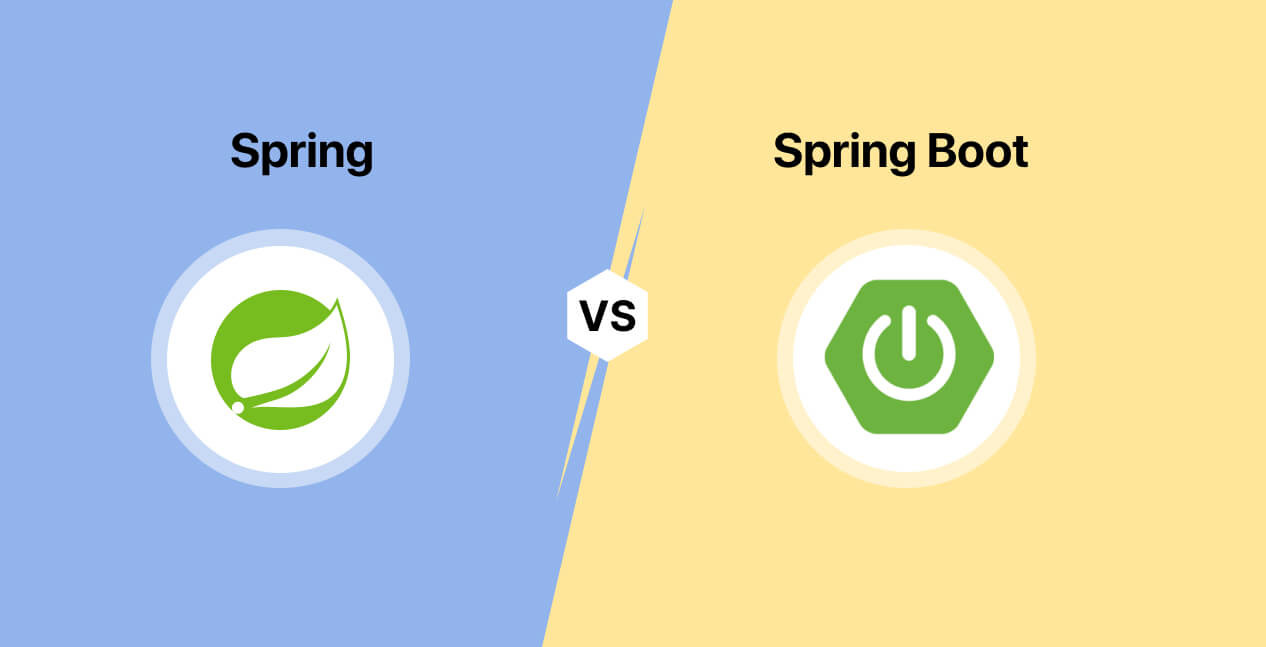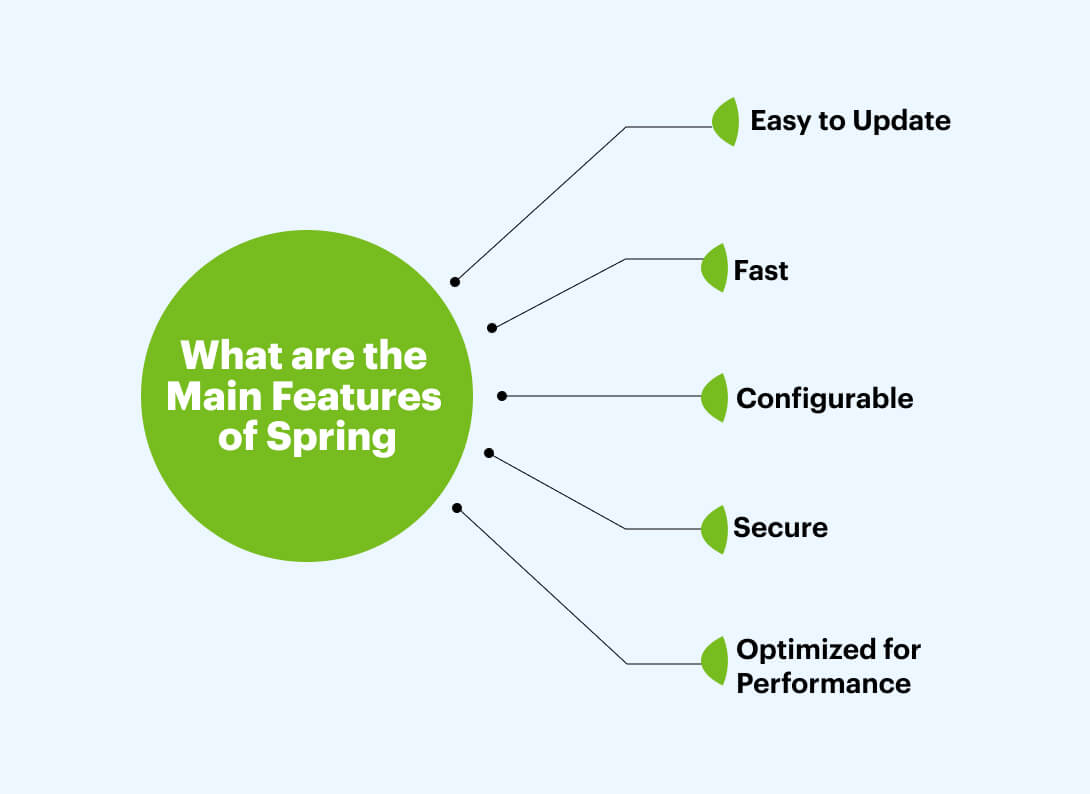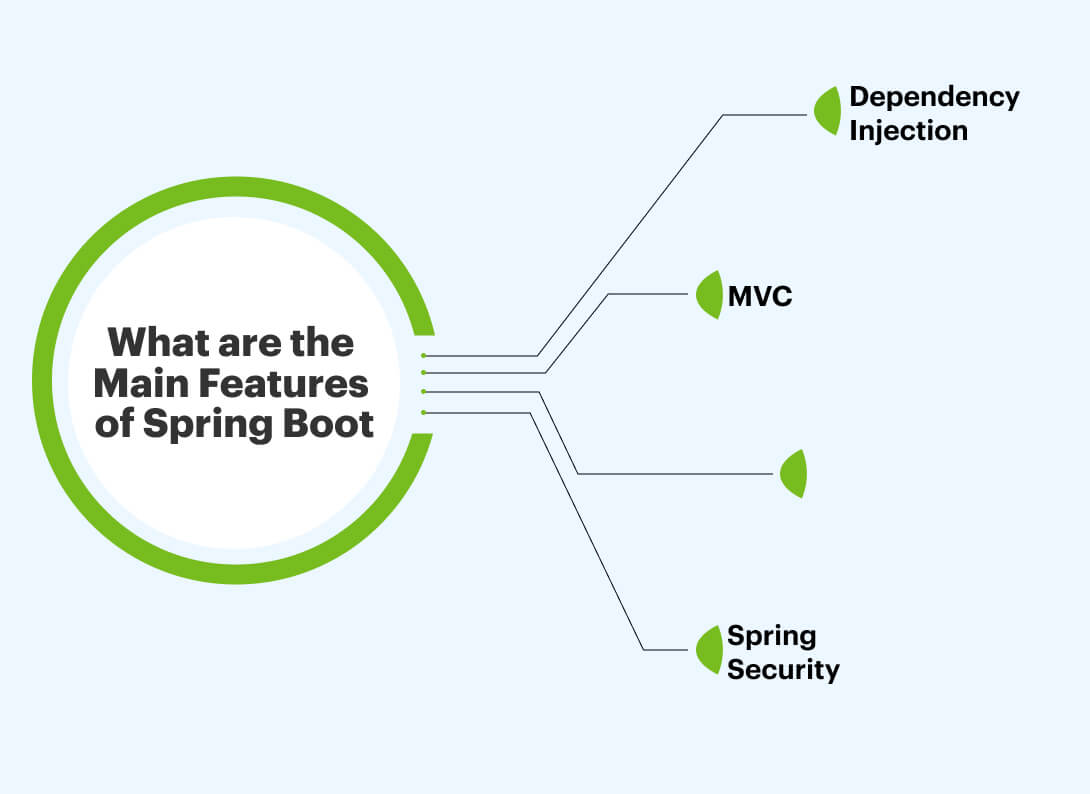Spring vs. Spring Boot : Intro
Spring and Spring Boot are two frameworks built in Java and utilized by developers for creating web applications. They provide similar capabilities like dependency injection, HTTP, and web application layer support. However, specific differences differentiate between the two frameworks. Spring Boot is a lightweight, higher-level Java application framework. This makes it ideal for rapidly developing applications with fewer code and dependency conflicts.
Additionally, Spring Boot is built on top of Spring Framework, similar to Spring MVC frameworks web applications. It’s also integrated with other open-source modules, including Jackson JSON serialization library, Groovy scripting language, and embedded database support via the H2 engine and Derby database platform. There are many differences between them, but at the root, we are looking at fundamentally different strategies for development in the age of microservices. In this article, you’ll learn about Spring framework vs. Spring Boot and how Spring Boot compares with Spring Framework so you can make an informed decision between the two.
What is Spring?
The Java platform offers comprehensive tools for building, deploying, and running applications. One of the most important of these tools is the Spring Framework. The Spring Framework provides a powerful building block for developing enterprise-ready applications.
These building blocks enable the creation of robust, reliable, and maintainable Java-based solutions that can scale to meet growing business needs. The Spring Framework is a collection of modular components designed to work together in a coordinated fashion to form a complete application platform. Spring is not a set of libraries or code. It’s a set of ideas and principles that can be implemented in any programming language. Spring lets you use the same application components regardless of the underlying technology.
The Spring Framework is an integration framework that provides tools for developing and deploying enterprise Java-based applications. It provides an object-oriented programming model for developing and deploying enterprise applications, including web applications, mid-tier applications, and data access components.
What are the Main Features of Spring
Spring is an open-source framework for developing web and enterprise applications. It is a comprehensive framework that supports Java EE and Spring Framework technologies. Spring provides MVC (Model-View-Controller) support out of the box with its support for WebFlux and Reactive programming styles. These features make building highly concurrent, resilient, and scalable. Spring can be used to create applications that are:
#Easy to update
Spring provides a simple and consistent way to write application code that supports relational database access and POJO (Plain Old Java Objects) based development. Spring also simplifies the application server configuration and deployment process.
#Fast
Spring takes advantage of best practices in software design by applying them across the board. This allows you to write fast applications with minimal effort without sacrificing robustness or flexibility. A model-view-controller (MVC) framework that supports both web and enterprise applications. The Spring MVC framework allows developers to create web applications using standard HTML/CSS/Javascript components with no additional code.
#Configurable
Spring provides a framework for building web applications. The Spring Framework is written in Java and provides a simple, flexible, robust foundation for developing enterprise applications. The Spring Framework lets developers focus on business logic, not on the lower levels of the application stack. It’s also lightweight and extensible, so developers can easily customize it to meet specific requirements.
#Secure
The built-in support for Hibernate makes it easy to create database-backed applications that perform well on any platform, regardless of its hardware capabilities or operating system version.
#Optimized for performance
Unlike many other frameworks based on heavyweight libraries like Struts or Hibernate, the Spring framework version focuses more on performance optimization than user interface design. This makes it more suited to rapidly evolving enterprise applications with high demands on latency. It offers a wide range of features that can be used to build highly scalable applications, including transaction management, message-driven architecture, and data access abstraction.
What are the Spring Use Cases?
Spring is a popular Java framework that allows developers to develop web applications. It provides various Java EE components and the flexibility to integrate them with other Java EE technologies such as JMS, JPA, and JTA. The Spring framework provides many valuable features such as Message-Driven Bean, Dependency Injection, AOP, etc. These features enable you to build highly customizable applications quickly while providing high performance and scalability.
Spring is a framework for building enterprise applications. It is an open-source project that offers several useful features, such as PaaS (platform as a service) and mobile support. As a standalone framework for building data-driven applications. Spring Data provides tools for working with relational and non-relational datasets and various service implementations to handle those datasets. It also includes an API for working with JSON content. Spring Security provides several layers of security, including authentication, authorization, or encryption; it also provides additional features like support for web sessions and OSGi bundles.
Advantages of Spring Framework
Spring Framework is a package that provides components for developing Java EE applications. Spring Framework allows you to create the entire application using the same infrastructure and code base. This reduces the maintenance cost and allows you to deploy your application faster.
Spring Framework is a collection of packages that provides many extensible JavaBeans, small pieces of reusable code that can be plugged into an application to perform specific tasks. Spring Framework provides many generic functionalities that can be used in different scenarios. Spring Framework comes with a set of namespaces and packages which support creating dynamic web applications, business-logic-driven applications, and desktop applications.
The Spring Framework is built on top of the Spring core library, which provides many standard services such as caching, message handling, logging, transaction management, etc. In addition to these core services, many extensions are available for specific needs. For example, the JMS extension supports Java Message Service (JMS) messaging.
What is Spring Boot?
Spring Boot is a lightweight, easy-to-use, and Spring-based Java application framework. It provides all the tools you need to build, package and launch applications quickly. Spring Boot is designed for rapid development and production deployment. Spring Boot is an open-source project that provides a complete and flexible Spring framework to create entire Java EE web applications.
Spring Boot provides several features for building modern web, microservices, and enterprise applications. You can use Spring Boot to build Spring-based applications for the Java EE platform and provide a complete Java EE application server stack, JPA 2 support, and much more. Spring Boot is a lightweight, flexible and powerful MVC framework. It’s the first and only complete Java application framework that uses Spring’s components to build entire enterprise applications with minimal effort. Spring Boot allows you to use your favorite Java technologies while providing a consistent, testable environment across the whole stack.
What are the Main Features of Spring Boot?
Spring Boot supports Spring Security, which lets you easily configure a new Spring Boot application to use Spring Security. The main features of Spring Boot include:
# Dependency Injection
You can replace your application code with simple annotations or XML configuration files, gaining automatic reference counting, autoconfiguration, and 100% test coverage. Spring Boot’s Dependency Injection (DI) feature provides a convenient way to inject dependencies into your application without needing configuration files or XML. This means you can’t rely on your code’s properties or other hard-coded values. Instead, you’ll have to create these yourself. Spring Boot uses Dependency Injection to inject the dependencies into the application context. It is a simple concept that allows you to declare your dependencies and their injection points.
MVC
Spring Boot provides an ideal foundation for building modern web applications with lots of data persistence capabilities such as database access, connections, and caching support. The Spring Boot Framework contains many features that make it easy to create web applications. One of these features is Model-View-Controller (MVC), which allows you to separate your code into three components: Model, View, and Controller. This allows the architecture of your application to be more modular and easier to maintain.
# Auto Configuration
Spring Boot supports auto-reloading and auto-updating of application resources, which makes it easy to automatically keep your application up-to-date with changes to the underlying Java environment. This feature is useful when working on multi-component applications or when you want to update the entire application in one go. Spring Boot supports the automatic configuration of projects by setting up various aspects, such as logging configuration, networking settings, etc., for you. This eliminates the need for manual configuration after setting up the project.
# Spring Security
The Spring-boot-starter-security starter makes it easy to quickly add support for Spring Security, including support for multiple authentication sources, custom user providers, and more. You can also create your custom security framework or extend the existing ones. Spring Security provides several mechanisms for protecting your data and users from unauthorized access, such as role-based access control (RBAC), message authentication codes (MAC), and policy-based authorization. Spring Security provides a comprehensive security framework that you can use to authenticate users, create access control lists (ACLs), protect against SQL injection attacks, enforce secure communication between threads, and more.
Advantages of Spring Boot
The Spring Boot framework is a lightweight, flexible, and opinionated set of Java-based technologies for the JVM that provide starter code for developing stand-alone Spring-based applications. It does not require the Spring Framework to run. Spring Boot is a project that provides tools and libraries for creating Spring-based web applications. It also supports embedded web applications, including Spring MVC and Spring WebFlux. Spring Boot is a lightweight Java application framework that makes it easy to develop and deploy RESTful web applications. It’s based on the Spring Framework and includes auto-configuration, dependency injection, and declarative configuration. Spring Boot allows you to create stand-alone Java web applications using only a few annotations.
Here are some advantages of Spring Boots:
1. Standalone
Spring Boot is a Java framework used to build web and enterprise applications. It can be used with the JVM to create standalone applications and embedded in other Java projects. The central concept of Spring Boot is to provide a lightweight, dependency-free, and portable way of creating standalone Java web applications. Spring Boot provides an alternative way of creating a web application by not requiring external dependencies like Maven or Gradle to run your code.
2. Flexibility
Spring Boot provides a set of well-known, proven, and battle-tested components that developers can use. The majority of these components are preconfigured and ready to go. Spring Boot provides many advantages over other Java application development frameworks like JEE, GWT, etc. Spring Boot has been created to address the challenges developers face daily. It provides a set of tools that can be used to build modern and robust applications.
3. Lightweight
Spring Boot is designed to be as lightweight as possible so that it doesn’t add unnecessary overhead to your application’s startup time. Spring Boot supports MVC architecture, which allows you to separate your concerns into different layers like the presentation, business logic, data access, etc. This helps in building modular and scalable applications with ease.
4. Mature
Spring Boot has been around for several years and is already widely used across various industries such as finance, retail, and ecommerce. It uses dependency injection for IoC (Inversion of Control), which makes it easy to configure the application and use it in different environments such as test, production, etc.
Difference between Spring and Spring Boot
Here are some fundamental differences between Spring and Spring Boot.
1. Key Features
Spring Boot is a lightweight Java application framework. It features minimal code and configuration to deploy, run, and manage enterprise Java applications. The Spring Boot project aims to provide a complete solution for developing, testing, and deploying applications with minimal effort. In contrast to Spring MVC, an open-source web framework for building web applications, Spring Boot is designed to build RESTful services that need to be deployed to multiple environments, including local development and continuous integration scenarios.
2. Reason of Usage
Spring is a Java framework for building applications. It is used to create enterprise-grade Java applications that are portable, reliable, and easy to maintain. Spring framework boot builds on the Spring framework by simplifying the process of creating Spring applications using its dependency injection capabilities.
Spring Framework is a software framework that helps you to create modular and testable applications. It supports writing code in POJOs (Plain Old Java objects) and many other features such as internationalization, security, testing, and more.
3. Application
Spring Boot provides an integrated way to create and run your application on the server using all the power of Spring Framework, including web and JMS support. The application is packaged as a single executable jar file that you can run as a standalone application or as part of an existing Spring Application Context.
Spring Boot makes it easy to develop modern Java web applications with minimal effort by eliminating the friction of complex setups. It is ideal for building microservices or lightweight cloud-native applications that can be deployed quickly, scaled independently, updated frequently, and even run in Docker containers.
Conclusion
Spring Boot is a new Java application framework developed by SpringSource, which provides support for building lightweight, production-grade microservices with minimal effort. It uses the same core framework as Spring Boot. Still, it adds additional features such as support for cloud-native environments like Kubernetes and Docker Swarm, auto-configuration, easy API Gateway integration, tooling integration (Jedis), etc. Spring Framework in JAVA is a full-fledged platform for building enterprise-grade, distributed Java applications. It consists of a modular architecture for building Spring-powered applications with support for configuration, two-way data binding, transaction management, concurrency, and security. If there are any questions, queries, or doubts, share your requirements, and our team will guide you through in no time.
Frequently Asked Questions
1. What is the main difference between Spring Boot and Spring Framework?
Spring Boot is a lightweight Java application framework that simplifies the development of Spring-based web and Java EE applications. It offers several benefits over the Spring Framework, including a smaller memory footprint, reduced startup time, and a more straightforward configuration. Spring Framework provides several services related to building enterprise applications. These include support for building Enterprise JavaBeans (EJBs), JMS support, XML processing, JPA 2 persistence and transactions support, and more. While this library is used for building enterprise apps, it is not part of the Spring Framework itself.
2. Is Spring Boot replacing Spring?
No, Spring Boot is a replacement for the Spring framework. It is built on top of the Spring framework and provides new features to simplify development for web applications.
3. Is Spring MVC and Spring Boot the same?
No, Spring Boot supports building RESTful services that comply with the new Java EE 8 standards. Spring MVC and Spring Boot are not the same things. They both provide different services, but they do have some similarities.
4. What is the REST API in Spring Boot?
REST API stands for Representational State Transfer. It is an architectural approach to building web applications that takes advantage of HTTP methods such as GET, POST, and PUT. The goal is to separate how a client accesses data from how it represents it. The latter is sometimes called a stateless API, and the former is called a stateful API.
COMMENT
No Comments found.
DETAILED INDUSTRY GUIDES
Software Development - Step by step guide for 2021 and
beyond | OpenXcell
Learn everything about Software Development, its types, methodologies, process outsourcing with our complete guide to software development.
Headless CMS - The complete guide for 2021 | OpenXcell
Learn everything about Headless CMS along with CMS, its types, pros & cons as well as use cases, and real-life examples in a complete guide.
Mobile App Development - Step by step guide for 2021 and beyond | OpenXcell
Building your perfect app requires planning and effort. This guide is a compilation of best mobile app development resources across the web.
DevOps - A complete roadmap for software transformation | OpenXcell
What is DevOps? A combination of cultural philosophy, practices, and tools that integrate and automate between software development and the IT operations team.
GET QUOTE
INSIGHTS INTO TECH
The inception of ChatGPT in 2022 marked the wide-scale adoption of Artificial Intelligence in application development. In the field of creating mobile apps, AI-powered tools and frameworks have become indispensable…
Read more...
Introduction Most industries have turned to AI to stay ahead of the competition in the evolving tech landscape. The construction industry is no stranger to this trend. The advent of…
Read more...
Introduction Digital transformation needs no introduction; it is evolving as a norm in many industries. The paradigm transition it brings to the retail landscape is evident from the latest predictions.…
Read more...








